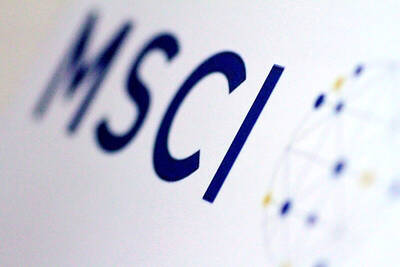Higher production costs and differing work cultures are unlikely to be decisive in the success or failure of Taiwan Semiconductor Manufacturing Co’s (TSMC, 台積電) expansion into the US, said Chris Miller, the author of Chip War: The Fight for the World’s Most Critical Technology.
In a recent interview, Miller, an associate professor at Tufts University’s Fletcher School of Law and Diplomacy, said that while Taiwan’s successful “model” in the chip industry is unlikely to be reproduced, Taiwanese companies still have to globalize their production in order to remain competitive.
To that end, TSMC has launched plans to build plants in Dresden, Germany, the US state of Arizona and Japan’s Kumamoto Prefecture.

Photo: CNA
The Arizona project in particular has faced a string of setbacks, including higher-than-expected costs, complaints by US employees of a “brutal” corporate culture, and construction delays at both factories it is building.
Despite these challenges, Miller said he disagreed with the notion that there is anything uniquely difficult about building chips in the US, adding that Samsung Electronics Co and Texas Instruments Inc both operated profitable plants there.
Intel Corp has also built chip plants in the US, and while they have had problems recently, those have mainly been related to design rather than construction, he said.
In terms of workplace culture, Miller said that leading countries in chip production — beginning with the US in the 1950s, then Japan and now Taiwan and South Korea — have always touted their respective work culture as being the best suited for the industry.
“It seems to me that the chip industry shifts too rapidly to have culture be a really effective explanatory factor,” Miller said.
Rather, in order to succeed, the onus is on companies to make sure that their work culture fits, or is capable of “assimilating,” in different geographies, he said.
Miller was also skeptical of the argument that higher production costs in the US would prove a major obstacle.
“TSMC’s success internationally has not been due to cost efficiency. It’s been due to better technology,” he said.
“I think over-focusing on cost underestimates what makes the Taiwanese workforce so effective,” which is related not to low wages, but the fact that they are highly skilled, he said.
Overall, Miller said he was waiting to see how TSMC worked through other challenges related to its US expansion, including making the Arizona facility work within its broader business.
As it does so, TSMC, as well as competitors Samsung and Intel, are all likely to receive assistance in the form of billions of dollars of US government subsidies, stemming from the Creating Helpful Incentives to Produce Semiconductors and Science Act in 2022, Miller said.

PERSISTENT RUMORS: Nvidia’s CEO said the firm is not in talks to sell AI chips to China, but he would welcome a change in US policy barring the activity Nvidia Corp CEO Jensen Huang (黃仁勳) said his company is not in discussions to sell its Blackwell artificial intelligence (AI) chips to Chinese firms, waving off speculation it is trying to engineer a return to the world’s largest semiconductor market. Huang, who arrived in Taiwan yesterday ahead of meetings with longtime partner Taiwan Semiconductor Manufacturing Co (TSMC, 台積電), took the opportunity to clarify recent comments about the US-China AI race. The Nvidia head caused a stir in an interview this week with the Financial Times, in which he was quoted as saying “China will win” the AI race. Huang yesterday said

Nissan Motor Co has agreed to sell its global headquarters in Yokohama for ¥97 billion (US$630 million) to a group sponsored by Taiwanese autoparts maker Minth Group (敏實集團), as the struggling automaker seeks to shore up its financial position. The acquisition is led by a special purchase company managed by KJR Management Ltd, a Japanese real-estate unit of private equity giant KKR & Co, people familiar with the matter said. KJR said it would act as asset manager together with Mizuho Real Estate Management Co. Nissan is undergoing a broad cost-cutting campaign by eliminating jobs and shuttering plants as it grapples

The Chinese government has issued guidance requiring new data center projects that have received any state funds to only use domestically made artificial intelligence (AI) chips, two sources familiar with the matter told Reuters. In recent weeks, Chinese regulatory authorities have ordered such data centers that are less than 30 percent complete to remove all installed foreign chips, or cancel plans to purchase them, while projects in a more advanced stage would be decided on a case-by-case basis, the sources said. The move could represent one of China’s most aggressive steps yet to eliminate foreign technology from its critical infrastructure amid a

MORE WEIGHT: The national weighting was raised in one index while holding steady in two others, while several companies rose or fell in prominence MSCI Inc, a global index provider, has raised Taiwan’s weighting in one of its major indices and left the country’s weighting unchanged in two other indices after a regular index review. In a statement released on Thursday, MSCI said it has upgraded Taiwan’s weighting in the MSCI All-Country World Index by 0.02 percentage points to 2.25 percent, while maintaining the weighting in the MSCI Emerging Markets Index, the most closely watched by foreign institutional investors, at 20.46 percent. Additionally, the index provider has left Taiwan’s weighting in the MSCI All-Country Asia ex-Japan Index unchanged at 23.15 percent. The latest index adjustments are to